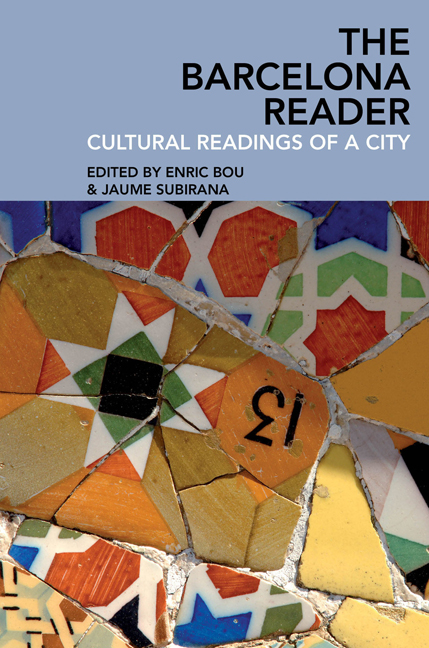Book contents
- Frontmatter
- Contents
- List of illustrations
- Notes on contributors
- Introduction: Barcelona: Cultural readings of a city
- I City, history, and territory
- 1 Barcelona: The siege city
- 2 Barcelona as an adaptive ecology
- 3 A present past, Barcelona street names, from Víctor Balaguer to Pasqual Maragall
- 4 ‘The asylum of modern times’: Barcelona and Europe
- 5 A fragile country
- II City and society
- III Art, architecture, and the city
- IV The Olympics and the city
- V Literature, cinema, and the city
1 - Barcelona: The siege city
from I - City, history, and territory
- Frontmatter
- Contents
- List of illustrations
- Notes on contributors
- Introduction: Barcelona: Cultural readings of a city
- I City, history, and territory
- 1 Barcelona: The siege city
- 2 Barcelona as an adaptive ecology
- 3 A present past, Barcelona street names, from Víctor Balaguer to Pasqual Maragall
- 4 ‘The asylum of modern times’: Barcelona and Europe
- 5 A fragile country
- II City and society
- III Art, architecture, and the city
- IV The Olympics and the city
- V Literature, cinema, and the city
Summary
Barcelona is a metropolis for which the concept of siege has specifically modern connotations. Captive in various forms for much of its history following the comprehensive defeat of Catalonia in 1714, what was to become the economic motor of Spain would learn to live under the watchful eyes, cannon and restrictive centrist policies of the Spanish state for the bulk of its modernization. What is more, around the turn of the twentieth century, a foundational period both in cultural and political terms, this external vigilance was supplemented in the Catalan capital by periods of brutal class warfare among its own citizens. The fact that this time of growth was inflected by urban violence only heightened the city's understanding of what it meant to be under prolonged attack as both working – and ruling-class Barcelona felt besieged from without and from within.
The city persisted and survived these trials. It withstood, as well, two military dictatorships in the twentieth century totalling some 43 years. In terms of urban expansion and growth the period of transition to democracy in 1975 would come to rival the latter half of the 1800s. As had happened during the first modern Catalan renaissance, Barcelona was able to slough off its overt prison garb as it built and developed frenetically. This process of revitalization culminated in the hosting of the 1992 Olympics. The ostensible success of those Games as a performance of urban possibility and renewal has resonated around the world ever since. Even though critics are increasingly questioning the ultimate consequences of this period, urbanists now point to a ‘Barcelona model’ – especially in terms of waterfront revitalization – as a way of helping urban centres connect not only to their citizenry but also to the built environment and their natural geographies as well.
Barcelona's arrival as a sought-out destination - an ‘in’ city - on the world's map, though, has been a mixed blessing. Among its valued attractions Gaudí and his contemporaries’ modernista architecture has helped confer upon Barcelona ‘must-see’ status for travellers to Europe. At the same time, the celebrated urban renewal has brought the holiday beach experience to within steps of the city proper. Similarly, the image of Barcelona has become one not of a specifically Catalan conurbation but rather of a cosmopolitan/sensorial experience that one consumes.
- Type
- Chapter
- Information
- The Barcelona ReaderCultural Readings of a City, pp. 21 - 42Publisher: Liverpool University PressPrint publication year: 2017

